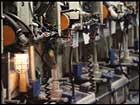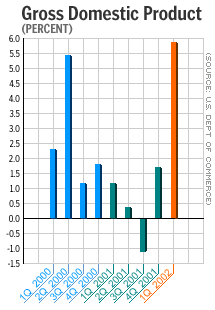
NEW YORK (CNN/Money) -
Business spending, often cited by Alan Greenspan as the key to the U.S. economy's recovery from its latest recession, will rebound, according to a recent study by economists at the Federal Reserve Bank of Chicago.
The bad news is that it might take its time.
Eric French, Thomas Klier and David Oppedahl, economists at the Chicago Fed, studied several historical indicators of business spending and found that an excess of unused production equipment gathering dust at U.S. businesses will keep spending muted for the next quarter or two.
"This will lead to below-trend growth in the near future," the economists said. "However, it does not signal further declines in investment spending. Instead, it signals an investment path that is consistent with our current investment forecast of 4.7 percent growth in 2002."
Business spending, which makes up $1.2 trillion of the $9.5 trillion U.S. economy, shrank at a rate of 5.7 percent in the first quarter, according to gross domestic product (GDP) data released Friday by the Commerce Department. It shrank at a 3.2 percent rate in all of 2001, following stunning growth rates of 9.9 percent and 8.2 percent in 2000 and 1999, respectively.

All that spending led to too much production capacity in U.S. factories, a massive inventory overhang, a dramatic slowdown in production, more than a million job cuts and, eventually, the broader recession.
When pay-back time came in 2001, capacity use plunged to just 72.9 percent in December 2001, far below the 40-year average of 81.5 percent. It crept back up to 75.4 by March 2002, but there's still a long way to go.
The Chicago Fed economists compared the last three times capacity use dipped below 75 percent -- in 1961, 1975 and 1982 -- and found that, in every instance, business spending returned to normal growth within three quarters of the trough.
In fact, only in 1982 did business spending turn negative at any point following the trough in capacity use, meaning business spending seems likely to turn positive this year, although it could be sluggish until the fourth quarter or so.
| |
 Related links
Related links
| |
| | |
| | |
|
"Today's low capacity utilization signals that investment growth will be above trend by the end of the year," the economists said.
They cited other historical indicators, including evidence that business spending almost never "double-dips" and that a glut of spending in 1997-2000 left investment levels 8 percent above historical trends.
All seemed to justify their belief that, while investment growth will be sluggish for much of 2002, much of the overhang that existed at the beginning of 2001 has disappeared, and spending will enjoy strong growth by the end of the year.

|

